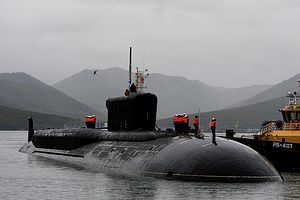The nuclear-powered ballistic missile submarine (SSBN) Vladimir Monomakh will join Russia’s Pacific Fleet before the end of the year, the Commander-in-Chief of the Russian Navy, Admiral Vladimir Korolev, told TASS news agency over the weekend.
“This year, Borei will be there, like we have promised,” Korolev said. The Vladimir Monomakh is the third boat of Russia’s new Project 955 Borei-class (“North Wind”) aka Dolgorukiy-class of SSBNs, designed by Rubin Marine Equipment Design Bureau and built by Northern Machine Building Enterprise in the port city of Severodvinsk.
The induction of the Vladimir Monomakh would be a major boost to the nuclear deterrence capabilities of the Pacific Fleet. In 2015, Russia’s Pacific Fleet, has received its first new Borei SSBN, the Alexander Nevsky. Four more new SSBNs of the class are expected to join the fleet before 2020.
As I have explained previously, the arrival of the Vladimir Monomakh had to be postponed a number of times:
The arrival of the Borei-class SSBN,Vladimir Monomakh, commissioned in December 2014, in the Pacific Ocean has been postponed due to outstanding trials (some sources indicate that the delay has been, in fact, due to a failure of the Russian defense industry to deliver a full set of Bulava ICBMs) to 2016.
Admiral Korolev’s recent press statement could indicate that the ICBMs are now available in sufficient numbers. In November 2015, the Vladimir Monomakh, successfully test fired two Bulava (RSM-56) ballistic missiles from a submerged position in the White Sea off the northwest coast of Russia.
As I have written for The Diplomat Magazine:
Each Borei-class SSBN can carry from 12 to 16 Bulava (RSM-56) intercontinental ballistic missiles (ICBM)–a sea-based variant of the Topol-M SS-27–armed with 6-10 warheads per missile. Consequently, one submarine can carry between 72 to 160 hypersonic, independently maneuverable warheads, yielding 100-150 kilotons apiece. The Bulava missile purportedly has range of over 8,300 kilometers (5,157 miles) and is specifically designed to evade Western ballistic missile defense shields. The new ICBM is intended to be the cornerstone of the sea-based component of Russia’s nuclear triad.
Next to the Vladimir Monomahk, the first sub of an improved variant of the Borei-class, the Knyaz Vladimir, designated Project 955A Borei II, is slated to join Russia’s Pacific Fleet in 2017. The upgraded SSBN variant is larger than the original Borei-class and can field four additional missile tubes, boosting the submarine’s firepower.
The Vladimir Monomakh will likely be permanently based at the Rybachiy Nuclear Submarine Base in Vilyuchinsk on the Kamchatka Peninsula. Rybachiy is home to the majority of Russia’s Pacific nuclear submarine fleet. The Pacific Fleet recently kicked off its annual summer training period.
































